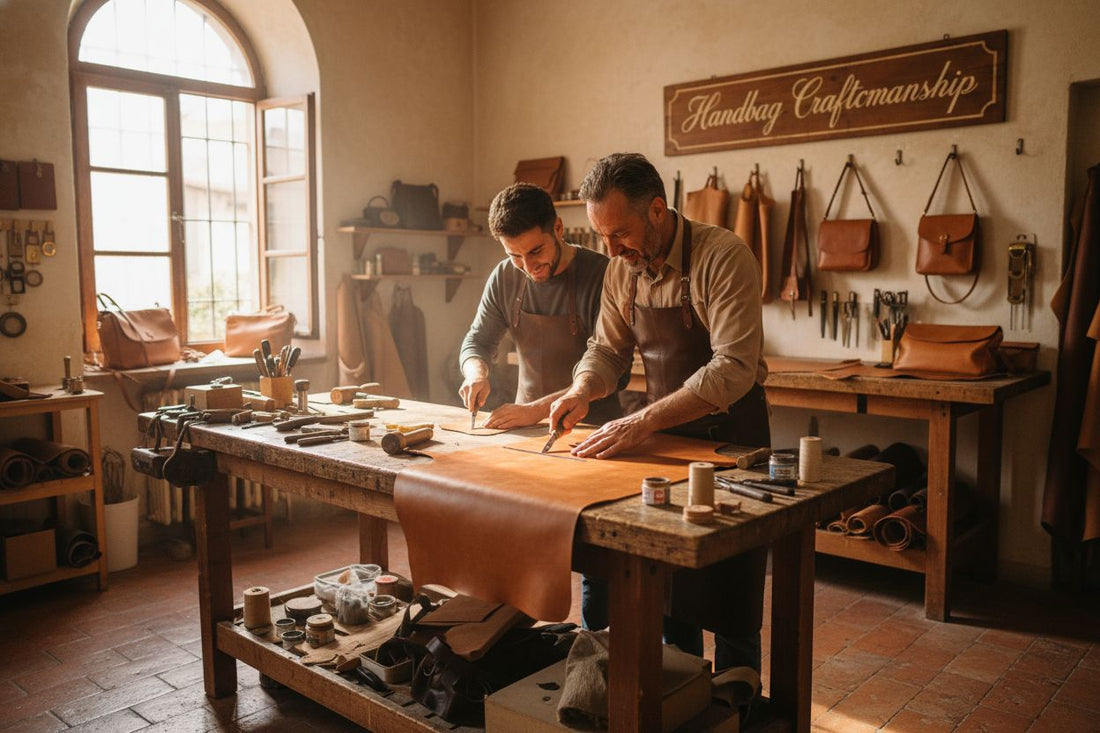
Understanding Italian Handbag Craftsmanship Explained
Share
Italian handbag craftsmanship stands out for its blend of centuries-old tradition with a level of technical skill that is almost unheard of elsewhere. You might think that modern machines would have replaced the need for this kind of artistry by now. But every stitch, cut, and seam in a genuine Italian bag is still made by skilled hands trained through generations, turning even simple leather into a work of art that’s as much about heritage as it is about high fashion.
Table of Contents
- The Essence Of Italian Handbag Craftsmanship
- Why Authenticity Matters In Italian Leather Goods
- The Art Of Materials: Selecting Quality Leather And Textiles
- Craft Techniques: Merging Tradition With Modernity
- The Cultural Heritage: Italian Craftsmanship’s Role In Fashion
Quick Summary
| Takeaway | Explanation |
|---|---|
| Authentic craftsmanship defines Italian leather goods | Authentic Italian handbags showcase exceptional quality, skill, and attention to detail that distinguish them from mass-produced items. |
| Material selection is crucial for quality | Artisans prioritise premium leather based on durability, texture, and aesthetic potential, ensuring long-lasting beauty and functionality. |
| Traditional techniques blend with modern innovations | The integration of advanced technology enhances traditional leather crafting methods, improving precision while preserving artisanal heritage. |
| Understanding leather quality is essential | Recognising grain consistency, markings, and tanning processes helps consumers identify genuine Italian leather products effectively. |
| Investing supports cultural heritage | Purchasing authentic Italian leather not only provides quality goods but also contributes to the preservation of artisanal skills and traditions. |
The Essence of Italian Handbag Craftsmanship
Italian handbag craftsmanship represents a pinnacle of artisanal excellence, blending centuries of tradition with unparalleled technical skill. At its core, this craft transcends mere manufacturing, embodying a profound cultural commitment to creating objects of extraordinary beauty and precision.
A Legacy of Artisanal Skill
The foundations of Italian handbag craftsmanship are deeply rooted in generational knowledge passed through skilled artisan families. These craftspeople do not simply create accessories but sculpt leather into sophisticated statements of design and functionality. Each handbag represents a narrative of technique, where hands trained over decades transform raw materials into exquisite pieces.
Key characteristics of authentic Italian handbag craftsmanship include:
- Meticulous hand-cutting of premium full-grain leather
- Precision stitching using traditional techniques
- Individually crafted components assembled with exceptional attention to detail
The Art of Material Selection
Selecting the right materials is fundamental to Italian leather craftsmanship. Artisans carefully choose leather based on its texture, durability, and potential for aesthetic refinement. According to Genuine Italian Leather Research Institute, premium Italian leather undergoes rigorous selection processes that consider grain consistency, natural markings, and potential for aging gracefully.
Understanding these nuanced selection criteria elevates a handbag from a mere accessory to a timeless piece of functional art. Explore our guide on understanding how Italian handbags are made to delve deeper into this intricate process.
Italian handbag craftsmanship represents more than manufacturing a product. It is a testament to cultural heritage, where every stitch, every carefully selected piece of leather, tells a story of dedication, skill, and an unwavering commitment to extraordinary quality.
Why Authenticity Matters in Italian Leather Goods
Authenticity in Italian leather goods is far more than a marketing term. It represents a comprehensive commitment to quality, heritage, and exceptional craftsmanship that distinguishes genuine Italian leather products from mass-produced alternatives.
The Economic and Cultural Significance
Authentic Italian leather goods are not merely accessories but economic and cultural statements. These products embody generations of skill, representing regional traditions that have been carefully preserved and refined over centuries. The economic impact of authentic Italian leather production extends beyond individual artisans, contributing significantly to Italy’s national manufacturing reputation.
Key indicators of authentic Italian leather craftsmanship include:
- Transparent sourcing of premium materials
- Handcrafted production techniques
- Rigorous quality control processes
- Minimal environmental impact
Understanding Genuine Leather Quality
Determining the authenticity of Italian leather requires understanding complex quality metrics. According to Leather Research International, genuine Italian leather is distinguished by specific technical and aesthetic characteristics that cannot be easily replicated.
These characteristics encompass:
![]()
- Grain consistency and natural leather markings
- Superior durability and aging properties
- Sophisticated tanning and finishing processes
For those seeking deeper insights, learn how to identify authentic leather through our comprehensive guide that breaks down the intricate details of genuine Italian leather manufacturing.
Authenticity is not just about the product itself but the entire ecosystem of design, production, and cultural preservation that surrounds Italian leather craftsmanship.
This table summarises the main characteristics that indicate the authenticity and high quality of Italian leather goods, aiding readers in distinguishing genuine products from imitations.
| Characteristic | Description |
|---|---|
| Transparent sourcing | Provenance of materials is clearly documented |
| Handcrafted techniques | Production involves skilled manual processes |
| Rigorous quality control | Each product undergoes thorough inspection |
| Environmental responsibility | Production minimises ecological impact |
| Grain consistency and markings | Natural features indicate high-grade, genuine leather |
| Superior durability and ageing | Leather improves with age, lasting many years |
| Sophisticated tanning processes | Advanced methods create a refined appearance and texture |
| When you invest in an authentic Italian leather product, you are supporting a rich tradition of artisanal excellence that continues to define global standards of quality and design. |
The Art of Materials: Selecting Quality Leather and Textiles
Selecting materials for Italian handbags is a nuanced art form that goes far beyond simple procurement. It represents a complex interplay of sensory evaluation, historical knowledge, and technical expertise that distinguishes exceptional craftsmanship from ordinary manufacturing.
The Science of Material Selection
Material selection in Italian leather goods is a sophisticated process that involves multiple layers of assessment. Artisans evaluate potential materials through comprehensive criteria that examine not just immediate appearance, but long-term performance, aesthetic potential, and environmental sustainability.
Key considerations in material selection include:
- Tactile quality and texture consistency
- Natural grain characteristics
- Potential for elegant aging and patina development
- Structural integrity and durability
- Environmental and ethical sourcing standards
Understanding Leather Grading and Quality
Leather quality is determined by multiple complex factors. According to European Leather Research Institute, premium Italian leather is classified through rigorous grading systems that assess grain quality, tensile strength, and natural markings.
Professional leather artisans prioritise:
- Full-grain leather with minimal surface treatments
- Natural markings that showcase leather’s authentic character
- Materials sourced from responsible, traceable supply chains
Explore our comprehensive guide on understanding Italian leather craftsmanship to gain deeper insights into this intricate selection process.
The art of material selection is ultimately about creating a harmonious relationship between raw material, artisan skill, and design vision. Each carefully chosen piece of leather or textile tells a story of cultural heritage, technical mastery, and an unwavering commitment to producing objects of extraordinary beauty and functionality.
Craft Techniques: Merging Tradition with Modernity
Italian handbag craftsmanship represents a sophisticated dialogue between time-honoured techniques and contemporary innovation. This delicate balance transforms traditional leather working methods into cutting-edge design solutions that respect historical artisanal knowledge while embracing technological advancements.
Preserving Historical Craftsmanship
Traditional leather crafting techniques form the bedrock of Italian handbag production. These methods, passed through generations of artisan families, involve intricate skills that cannot be replicated by machine production. Techniques such as hand cutting, precision stitching, and manual edge finishing represent a living cultural heritage that goes beyond mere manufacturing.
Key traditional craft techniques include:
- Hand skiving of leather edges for seamless joins
- Manual pattern cutting using generational techniques
- Intricate hand stitching with specialized tools
- Precise leather conditioning and preparation
- Detailed manual quality inspection processes
Technological Integration in Modern Craftsmanship
Modern Italian leather crafting seamlessly integrates advanced technologies without compromising traditional skills. According to European Design and Craftsmanship Institute, contemporary artisans are leveraging digital tools to enhance precision while maintaining the essential human touch.
Technological innovations transforming leather craftsmanship include:
- Computer-aided design for intricate pattern development
- Laser cutting for unprecedented precision
- Advanced material testing technologies
- Digital archiving of traditional technique documentation
Explore our guide on understanding Italian leather craftsmanship to discover how these innovative techniques preserve and elevate traditional skills.
The true art of Italian handbag craftsmanship lies in its ability to honour historical techniques while remaining dynamically responsive to contemporary design needs.
The following table compares traditional Italian handbag craftsmanship techniques with modern technological approaches, highlighting their unique aspects and respective contributions to quality and design.
| Approach | Key Techniques/Innovations | Contribution to Craftsmanship |
|---|---|---|
| Traditional Methods | Hand skiving, manual pattern cutting, intricate hand stitching, leather conditioning | Preserves heritage, ensures uniqueness, showcases artisan skill |
| Technological Integration | Computer-aided design, laser cutting, material testing, digital archiving | Improves precision, supports sustainability, documents techniques |
Each handbag becomes a testament to this extraordinary balance between reverence for tradition and bold, forward-thinking innovation.
The Cultural Heritage: Italian Craftsmanship’s Role in Fashion
Italian craftsmanship transcends mere manufacturing, representing a profound cultural narrative that has fundamentally shaped global fashion aesthetics and design philosophy. This rich heritage is not simply about creating products, but about preserving a sophisticated artistic tradition that communicates identity, skill, and cultural excellence.
Historical Roots of Italian Design Excellence
The origins of Italian craftsmanship are deeply embedded in regional traditions, where artisanal skills were meticulously transmitted through generations. Each geographical area developed distinct techniques that reflected local resources, cultural influences, and generational expertise. Leather working, in particular, emerged as a quintessential expression of Italian creative genius, transforming functional objects into statements of artistic brilliance.
Key historical characteristics of Italian craftsmanship include:
- Emphasis on individual artisan skill
- Regional specialization in specific craft techniques
- Prioritization of quality over mass production
- Intricate connection between artistic expression and functional design
- Deep respect for material integrity and transformation
Global Influence and Contemporary Significance
Italian craftsmanship has profoundly influenced international fashion standards. According to European Fashion and Heritage Institute, Italian design approaches have consistently redefined global aesthetic expectations, establishing benchmarks for quality, innovation, and elegance.
Contemporary contributions of Italian craftsmanship encompass:
- Setting international design standards
- Promoting sustainable and ethical production methods
- Preserving traditional skills in a rapidly changing global economy
- Inspiring innovative design approaches worldwide
Discover more about the rich history of Italian bags and understand how these extraordinary cultural traditions continue to shape modern fashion narratives.
Ultimately, Italian craftsmanship represents more than a manufacturing approach. It is a living cultural language that communicates stories of creativity, dedication, and uncompromising commitment to beauty through every meticulously crafted object.

Experience True Italian Craftsmanship with San Rocco Italia
After exploring the secrets behind genuine Italian handbag craftsmanship in our article, you might wonder how to find handbags that truly embody such dedication to tradition, exceptional material selection and ethical sourcing. Too often, discerning individuals face the frustration of imitation leather goods or mass-produced accessories that lack the soul and artistry discussed above. Embracing authentic Italian design means searching for the unmistakable qualities of premium full-grain leather, expert stitching, and a legacy of cultural pride—all elements that set luxury handbags apart.
Are you ready to own a handbag that tells a story of artistry and heritage? At San Rocco Italia, each handbag is a result of these time-honoured techniques and materials you have just read about. Every piece supports skilled women artisans and upholds the traditions described in our guide to identifying authentic leather. With our commitment to partnering only with trusted European makers, you are assured that every accessory stands for trust, heritage and enduring value.

Begin your own journey into the world of authentic Italian luxury today. Browse our curated selection at San Rocco Italia, and experience first-hand the artisanal touch, quality and timeless design celebrated in the article. Select now to elevate your personal collection with a piece of true Italian craftsmanship.
Frequently Asked Questions
What are the key characteristics of authentic Italian handbag craftsmanship?
Authentic Italian handbag craftsmanship is characterised by meticulous hand-cutting of premium full-grain leather, precision stitching using traditional techniques, and individually crafted components assembled with exceptional attention to detail. To assess craftsmanship, examine the stitching quality and the choice of materials used in the handbag.
How can I determine the quality of Italian leather?
The quality of Italian leather can be determined by examining the grain consistency, natural markings, and the leather’s durability and aging properties. Look for full-grain leather with minimal surface treatments, as this often indicates superior quality.
What traditional craft techniques are used in Italian handbag production?
Traditional craft techniques include hand skiving of leather edges, manual pattern cutting, and intricate hand stitching. To appreciate these techniques better, consider visiting workshops or exhibitions that showcase these artisanal methods in practice.
How does technology enhance modern Italian handbag craftsmanship?
Technology enhances modern Italian handbag craftsmanship by integrating computer-aided design for precision pattern development and laser cutting for accuracy. Observe how these innovations maintain the essential human touch while improving the overall quality of the production process.
Why is authenticity important in Italian leather goods?
Authenticity in Italian leather goods represents a commitment to quality, heritage, and exceptional craftsmanship, distinguishing genuine products from mass-produced alternatives. Consider supporting authentic products as a way to preserve cultural heritage and craftsmanship traditions.
How can I identify authentic Italian handbag craftsmanship?
Identifying authentic Italian handbag craftsmanship involves looking for transparent sourcing of materials, handcrafted production techniques, and rigorous quality control processes. Inspect the handbag’s stitching and material quality to ensure it meets the high standards associated with Italian craftsmanship.


